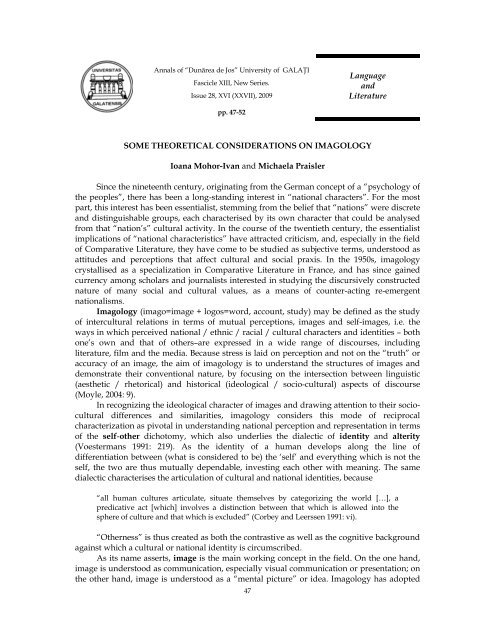You also want an ePaper? Increase the reach of your titles
YUMPU automatically turns print PDFs into web optimized ePapers that Google loves.
Annals of “Dunărea <strong>de</strong> <strong>Jos</strong>” University of GALAŢI<br />
Fascicle XIII, New Series.<br />
Issue 28, XVI (XXVII), 2009<br />
pp. 47-52<br />
47<br />
Language<br />
and<br />
Literature<br />
SOME THEORETICAL CONSIDERATIONS ON IMAGOLOGY<br />
Ioana Mohor-Ivan and Michaela Praisler<br />
Since the nineteenth century, originating from the German concept of a “psychology of<br />
the peoples”, there has been a long-standing interest in “national characters”. For the most<br />
part, this interest has been essentialist, stemming from the belief that “nations” were discrete<br />
and distinguishable groups, each characterised by its own character that could be analysed<br />
from that “nation’s” cultural activity. In the course of the twentieth century, the essentialist<br />
implications of “national characteristics” have attracted criticism, and, especially in the field<br />
of Comparative Literature, they have come to be studied as subjective terms, un<strong>de</strong>rstood as<br />
attitu<strong>de</strong>s and perceptions that affect cultural and social praxis. In the 1950s, imagology<br />
crystallised as a specialization in Comparative Literature in France, and has since gained<br />
currency among scholars and journalists interested in studying the discursively constructed<br />
nature of many social and cultural values, as a means of counter-acting re-emergent<br />
nationalisms.<br />
Imagology (imago=image + logos=word, account, study) may be <strong>de</strong>fined as the study<br />
of intercultural relations in terms of mutual perceptions, images and self-images, i.e. the<br />
ways in which perceived national / ethnic / racial / cultural characters and i<strong>de</strong>ntities – both<br />
one’s own and that of others–are expressed in a wi<strong>de</strong> range of discourses, including<br />
literature, film and the media. Because stress is laid on perception and not on the “truth” or<br />
accuracy of an image, the aim of imagology is to un<strong>de</strong>rstand the structures of images and<br />
<strong>de</strong>monstrate their conventional nature, by focusing on the intersection between linguistic<br />
(aesthetic / rhetorical) and historical (i<strong>de</strong>ological / socio-cultural) aspects of discourse<br />
(Moyle, 2004: 9).<br />
In recognizing the i<strong>de</strong>ological character of images and drawing attention to their sociocultural<br />
differences and similarities, imagology consi<strong>de</strong>rs this mo<strong>de</strong> of reciprocal<br />
characterization as pivotal in un<strong>de</strong>rstanding national perception and representation in terms<br />
of the self-other dichotomy, which also un<strong>de</strong>rlies the dialectic of i<strong>de</strong>ntity and alterity<br />
(Voestermans 1991: 219). As the i<strong>de</strong>ntity of a human <strong>de</strong>velops along the line of<br />
differentiation between (what is consi<strong>de</strong>red to be) the ‘self’ and everything which is not the<br />
self, the two are thus mutually <strong>de</strong>pendable, investing each other with meaning. The same<br />
dialectic characterises the articulation of cultural and national i<strong>de</strong>ntities, because<br />
“all human cultures articulate, situate themselves by categorizing the world […], a<br />
predicative act [which] involves a distinction between that which is allowed into the<br />
sphere of culture and that which is exclu<strong>de</strong>d” (Corbey and Leerssen 1991: vi).<br />
“Otherness” is thus created as both the contrastive as well as the cognitive background<br />
against which a cultural or national i<strong>de</strong>ntity is circumscribed.<br />
As its name asserts, image is the main working concept in the field. On the one hand,<br />
image is un<strong>de</strong>rstood as communication, especially visual communication or presentation; on<br />
the other hand, image is un<strong>de</strong>rstood as a “mental picture” or i<strong>de</strong>a. Imagology has adopted












